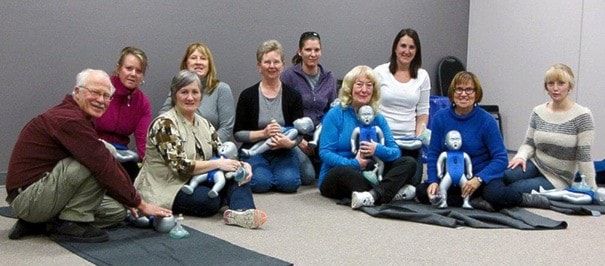Imagine you are enjoying at day at the park when a stranger near you collapses. Someone shouts, “She’s not breathing!” Or, imagine enjoying a family dinner when your relative says they are having trouble breathing. What do you do? Your response in both of these situations could be the difference between life and death.
Last month, nine locals took part in CPR and AED training hosted by the Seniors Fit for Life Program & Instructed by St. John’s Ambulance. The group learned how to make life saving decisions. The Instructor reminded the group that they are not being trained to be health professionals, rather they are being trained to sustain life until a trained professional arrives to take over. According to the Heart & Stroke Foundation Canada, there is one cardiac arrest every 12 minutes. Without rapid and appropriate treatment, most of these cardiac arrest will result in death.
Recently, we have seen the increase of the availability of Automated External Defibrillators (AED). An AED is a small, portable device used to identify cardiac rhythms and deliver a shock to correct abnormal electrical activity in the heart. As a result of the sophisticated electronics in an AED the operator will only be advised to deliver a shock if the heart is in a rhythm which can be corrected by defibrillation. If a shockable rhythm is not detected, no shock can be given and the provider will be instructed to perform cardiopulmonary resuscitation (CPR) until emergency medical services arrive.(3) When an AED and CPR are immediately available, the chance of survival from sudden cardiac arrest is substantially improved.1 Combined with CPR, the use of an AED may increase the likelihood of survival by 75 per cent or more.2 Training in CPR and availability of AEDs cannot be overemphasized.
Last Feb. 14, my friend had a sudden cardiac arrest. I, along with others knew what to do when my friend lay without a pulse or breath. Along with our First Aid and CPR training we were blessed to have an AED which was put into use immediately. That, along with others standing by in prayer, others waving in the ambulance and others just staying out of the way, my friend is alive and well today. Thank God, we knew what to do! Do you?
References:
1.Link MS, Atkins DL, Passman RS, Halperin HR, Samson RA, White RD, et al. Part 6: Electrical Therapies Automated External Defibrillators, Defibrillation, Cardioversion, and Pacing 2010 American Heart Association Guidelines for Cardiopulmonary Resuscitation and Emergency Cardiovascular Care. Circulation 2010;122(suppl 3):S706-S719.
2.Weisfeldt ML, Sitlani CM, Ornato JP, Rea T, Aufderheide TP, Davis D et al. Survival after application of automatic external defibrillators before arrival of emergency medical system: Evaluation in the Resuscitation Outcomes Consortium population of 21 million. Journal of the American College of Cardiology 2010;55(15):1713-20
3.Heart & Stroke Foundation of Canada
Vicky Trill
